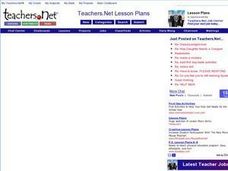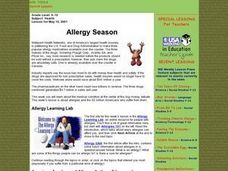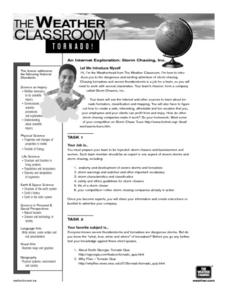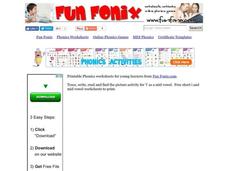Curated OER
Forces in a Climb
Students use a NASA website to use a given formula to find acceleration and distance after a specific time and how it relates to engine propulsion.
Curated OER
Looking at Teachers Among Us: A Workshop in Conceptions of Teaching
Students characterize various traditional conceptions of teaching and apply these to authentic teaching situations. Teaching art, math and grading systems are analyzed in this lesson.
Curated OER
Rhythmic Pattern and Expressive Movement
Students use the song Row Row Row Your Boat to help them learn patterns and expressive movement. They recreate the movement over and over until it is a pattern and they feel comfortable doing it.
Curated OER
Credit as Currency: Ancient World History
Students examine use and principles of currency as it relates to the establishment and continuation of credit and banking systems.
Curated OER
Rhythmic Pattern and Movement
Students practice repeating rhythmic patterns in unison. Next, students work in groups to practice an alternate rhythmic pattern to Row, Row, Row Your Boat. They create their own rhythmic patterns for the song.
Curated OER
AB Form Through Movement
Students listen to music by Ludwig Van Beethoven and figure out the form of the piece. They create binary forms for additional songs, and then practice the rhythms with eurythmic movement.
Curated OER
Allegry Season
Students use the Internet to research allergies. They discover different companies which are involved in helping Americans relieve their allergy symptoms. They finally discover the different types of allergy causing agents.
Curated OER
Environment
Students examine how connected they are to the environment and how organisms are affected by other organisms. They also discover that the environment is affected by human interactions.
Curated OER
Water Pollution, Stream Ecosystems
Students participate in a series of simulated activities designed to demonstrate the interconnectedness between the environment and the organisms that live there. They explore how polluting one element of an environment affects the...
Curated OER
Storm Chasing, Inc.
Students use the internet to research storm chasing. They develop their own lesson plan and present it to the class. They create a visual for their lesson as well.
Curated OER
Respect the Beach
Students work together to compare and contrast sand particles. They identify what sand grains are composed of as well. They complete writing activities to complete the lesson.
Curated OER
Investigating Ocean Life
Sixth graders explore the various forms of ocean life. They research a creature that lives in the ocean. Students use their research information to create a series of HyperStudio stacks about their sea creature.
Curated OER
Exploring the Self
High schoolers use different pieces of music and writings to explore the theme of self-reliance and individuality. After viewing a video clip, they discuss how the images made them feel. They keep a writing journal to evaluate their...
Curated OER
Velocity and Acceleration
Twelfth graders look at local speed limits and traffic controls and see if they are reasonable. They plot the displacement and time to represent velocity, develop a plan for improving the current system, and organize experimental...
Curated OER
Reduce, Reuse, Recycle
Fourth graders discover the differences between: reduce, reuse, and recycle by performing hands on examinations. They list what would happen to the soil if we allowed the earth to wash away and briefly discuss the meaning of erosion.
Curated OER
Simple Machines III - Pulleys
Fourth graders are introduced to a spring scale to show that the forces on both sides of the pulley are the same. They break into groups to lift objects with fixed pulleys and with multiple looped pulleys and then measure the force...
Curated OER
Introductions and Conclusions
Ninth graders explore the techniques for writing an effective introduction and concluding paragraph in their academic essay. They create an outline of where they plan to take the reader and explore the methods for creating an...
Curated OER
Law of Demand
Students review the law of demand. Using the law, they read a demand schedule and demand curve. They draw their own demand curve from data supplied to them. They identify and explain the four determinants of demand and work together...
Curated OER
Lattice Method of Multiplication Variances
Students explore the lattice method of mulitplication variances through the game "Multiplication Wrestling." They view a model of how to play the game and play three rounds, recording their patterns and discussing the strategies used to...
Curated OER
Equations 1
Students discuss the meaning of balance and how it applies to equations. After listening to a lecture, they practice solving equations with two orders of operation and doing whatever they do on one side to the other side as a class. To...
Curated OER
Integers and Fractions
Students perform operations using positive and negative numbers as well as operations with fractions in various forms. They identify common decimals and their fraction equivalents while converting fractions to decimal form.
Curated OER
Scientific Notation
Students observe the teacher writing numbers and determine the rules for scientific notation. After explanations, they perform operations on numbers in scientific nation and discuss reasons for using this method of writing numbers and...
Curated OER
Song Writing: Recording Your Song
In this music worksheet, students read an excerpt on recording with a company, who the producer is, and what arrangements need to be made. They respond to six short answer questions related to recording their own song in a studio.
Curated OER
Short Vowel I
In this letter i worksheet, 1st graders will read pictures that have the letter i sound. Students will then trace 5 words and write them on the lines provided before drawing a line from the word to the correct picture it represents.
Other popular searches
- Intro to Business
- Intro to Poetry
- Intro to European Geography
- Intro to Credits
- Intro to Graphing Equations
- Intro to Language
- Intro to Human Skeleton
- Intro to Business Marketing
- Intro to Biology
- Intro to Frequency Tables
- Intro to Musical Form
- Intro to Computers

